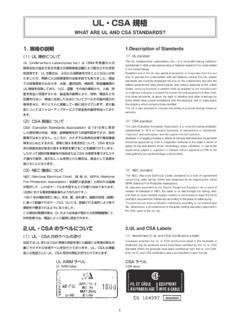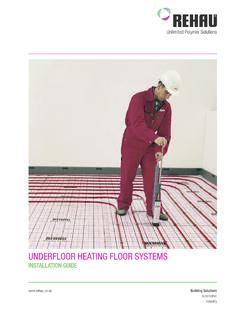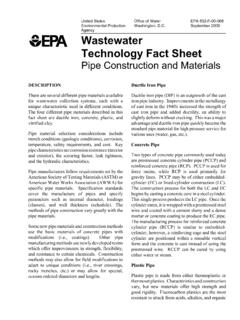Transcription of Fire Alarm Cables - West Penn Wire
1 GuideFire Alarm Cables Initiating Device , SLC Lines, and NAC STANDARDSFire Alarm Systems A fire Alarm system is number of devices working together to detect and warn people through visual and audio appliances when smoke, fire, carbon monoxide or other emergencies are present. These alarms may be activated automatically from smoke detectors, and heat detectors or may also be activated via manual fire Alarm activa tion devices such as manual call points or pull stations. Alarms can be either motorized bells or wall mountable sounders or horns. Fire Alarm System Design After the fire protection goals are established usually by referencing the minimum levels of protection mandated by the appropriate model building code, insurance agencies, and other authorities the fire Alarm designer undertakes to detail specific components, arrangements and interfaces necessary to accomplish these goals.
2 Equipment specifically manufactured for these purposes is selected and standardized installation methods are anticipated during the design. In the United States, NFPA 72, The National Fire Alarm Code is an established and widely used installation standard. In Canada, the ULC is the standard for the fire system. AInitiating DevicesNAC Notification Appliance Circuits CablesFire Alarm Control PanelAquaseal Indoor/ Outdoor CablesCommunication CablesSLC Signal Line Circuits OF CONTENTSFire Alarm Systems ..1 Conventional Fire Alarm Systems ..2 Power Limited vs. Non Power Limited ..3 Conventional Fire Alarm Cables ..4 Addressable Fire Alarm Systems ..5 Addressable Fire Alarm Cables ..6 West Penn Wire Fire Alarm Cable Guide ..6 Aquaseal Water resistant Cables .. Alarm System 1 AInitiating DevicesNAC Notification Appliance Circuits CablesFire Alarm Control PanelAquaseal Indoor/ Outdoor CablesCommunication CablesSLC Signal Line Circuits CablesFire Alarm Control Panel (FACP)FACP is the Hub of the system, monitors inputs and system integrity, controls components and communicates to components and outside Devices and SLC LoopsInitiating devices consist of Pull Stations, Call points, automatic heat, smoke flame detectors and other devices that initiate a communication back to the Signal Line Circuits are initiating devices in an Addressable Fire Alarm Applicance NAC DevicesNotification devices notifiy in building occupants about a problem.
3 This is done by audible, visible, tactile, and textual devices. Alarm SystemsFire Alarm systems can be put into three system designs. Conventional (Analog), Addressable (Digital) and Multiplex systems ( Analog/Addressable)Conventional Systems (Analog)Conventional Fire Alarm Systems, in their various forms, have been around for many of years and have changed little in that time in terms of technology although design and reliability have impoved , Conventional systems are a well proven technology protecting many hundreds of thousands of properties world wide. A Conventional Fire Alarm System is often the natural choice for smaller systems or where budget constraints exist. In a Conventional Fire Alarm System the Intelligence of the system resides solely within the Fire Alarm Control panel receives a trigger signal from a Conventional Detector or Initiating DeviceCircuit (Smoke, heat, flame detectors) which in turn signals the condition to the Notification (Indicating)Device Circuit such as Alarm sounders, horns, strobes and other remote signalling detectors are normally connected to the Fire Control Panel via dedicated circuits, each circuit protecting a designated Zone or area of the system has different modes.
4 Normal, Alarm , Trouble, and others, depending on the Fire Alarm Fire Alarm DesignCThe designer must be sure that the last device on the circuit has sufficient voltage to operate the device within its rated calculating the voltage available to the last device, it is necessary to ocon sider the volt age drop due to the resistance of the larger the wire, the less the voltage , for purposes of determining the wire size necessary for the system, it is best to consider all ofthe devices as lumped on the end of the supply circuit, this simulates the worst wire size resistance: Loop Resistance18 AWG solid: Approximately 13 AWG solid: Approximately AWG solid: Approximately AWG solid: Approximately Devices (Zone #)Initiating Devices (Zone #)Notification DevicesEOL ResistorsEOL Limited and Non-Power Limited SystemsConventional FA Cables are designed based upon the AWG of the Cable.
5 Conventional systems can be broken into two categories: Power Limited and Non Power Limited. Power Limited is the dominant designed system. Power FPL FPL power limited fire Alarm cable is listed by the NEC as being suitable for general purpose fire Alarm listing excludes installation in riser, ducts, plenums and other space used for environmental air unless the cable is installed in FPL Cables are listed as being resistant to the spread of fire and must pass both UL test 1424 and the vertical flame testUL FPLR FPLR power limited fire Alarm riser cable is listed asbeing suitable for use in a vertical run in a shaft or from floor to FPLR Cables are listed as having fire resistant characteristicscapable of preventing fire from traveling from floor to Cables must pass both UL test 1424 and the Vertical riser test UL FPLP FPLP power limited fire Alarm cable is listed by the NEC as being suitable for usein ducts.
6 Plenums and other space used for environmental FPLP cable are listed as having adequate fire resistant and low smokeproducing characteristics and must pass bothUL test 1424 and UL Stiener tunnel test 910. (NFPA262) No Voltage Rating Markings on PLFA Cables CL3 and CM rated Cables , which have a voltage rating of 300V are permitted to be used as PLFA Cables . Power limited is inherently limited by the power supply Transformer Other Power Supply DevicesNon-Power NPLF NPLF Non power limited fire Alarm cable is listed by the NEC as being suitable for general pur pose fire Alarm listing excludes installation in riser, ducts, plenums and other space used for environmental air unless the cable is installed in NFPL Cables are listed as being resistant to the spread of fire and must pass both UL test 1424 and the verticalflame test UL NPLFP NPLFP Non power limited fire Alarm cable is listed by the NEC as being suitable for use in ducts, plenums and other space used for environmental NPLFP cable are listed as having adequate fire resistant and low smoke producing characteristics and must pass bothUL test 1424 and UL Stiener tunnel test 910.
7 (NFPA262) Power source of NPLFA circuits output voltage shall not exceed 600 Marking on NPLF Cables are not addressed as use in 150V or less on NPLF circuits( out of tray or conduit) Class 1 Cables can be installed and used as NPLFA, but must be placed in a tray or conduit. Overcurrent devices shall be located at the point where the device to be protected receives its FA CablesConductor: Shall not be smaller than a 26 AWG Single Conductor no smaller than 16 AWG Solid or Stranded Conductor. Bare Copper for low DCRI nuslation: PVC or Polypropylene Insulation FPLR Fire/Flame Retardant PVC for Plenum Rated FPLP West Penn Wire B Series Conductors are either Cabled or Twisted pair. West Penn Wire 2 Conductor Cables are twisted. Shield: Dependent on the system requirements and environmental conditions Unshielded or Shielded Shield is used to protect against interference created from other Cables or outside electronic/ electrical or mechanical devices.
8 Shield is normally 100% Aluminum foil wrapJacket: PVC for Non Plenum FPLR Flexible Fire Retardant PVC for FPLP Jacket Color: Normally Red, but can be any color. West Penn Wire has the capability to Strip the cable Characteristics: Nom. DCR (AWG Size) is the most important electrical property in Conventional systems. Capacitance: Te capacitance is not an important electrical property in Conventional systems. Notes: Initiating Devices and the associated Cables communicate back to the FACP the information about that Cables AWG size is the important factor to deliver the analog signals to the FACP. You will find that normally 18 16 AWG Devices and associated Cables send power to the devices. You will find that normally 16 12 AWG Cables are utilized. ( Multiplex) FA SystemsAddressable Fire Alarm Systems differ from conventional systems in a number of ways and certainly addmore flexibility,intelligence, speed of identification and scope of this reason, Addressable Fire Alarm Sys tems are the natural choice for larger premises and buildings with morecomplex system an Addressable system, detectors are wired in a loop around the building with each detector havingits own unique system may contain one or more loops depending upon the size of the sys tem and design Fire Control Panel communicates with each detector individually andreceives a status report Normal, Alarm , Trouble each detector has an individual address thefire Alarm control panel is able to display or indicate the precise location of the device in question.
9 Whichobviously helps speed the location of an incident and for this reason zoning of the system is not neces sary, although it may be done for detectors are, in themselves, intelligent devices which are capable of reporting far morethan just fire or fault analog addressable detectors are able to signal if contamination inthe device reaches a pre set level enabling maintenance to take place prior to problems being most earlier styles of Addressable systems, the notification appliances were not ,many manufacturers are providing addressable notification are many advantages ofproviding such as lower cost of wire, and overall installation Cable SelectionThe designer must be aware of not only the Resistance of the cable, but the capacitance and theVelocity of proporgation of the designer must assure that the overall loop capacitance is notcompromised, and er ror rates are kept to a Capacitance for wire sizes:18 AWG solid unshielded: 16pf/ft18 AWG solid shielded: 25pf/ft t45pf/ft **16 AWG solid unshielded: 17pf/ft16 AWG solid shielded: 30pf/ft 54pf/ft **14 AWG solid shielded: 30pf/ft.
10 54pf/ft **12 AWG solid shielded: 35pf/ft. 63pf/ft **Capacitance between one conductor and the other connected to the Loop (Address #)Notification Devices(Address #) (Address #)(Address #)(Address #)(Address #) 6 Addressable FA CablesConductor: Shall not be smaller than a 26 AWG Single Conductor no smaller than 18 AWG Solid or Stranded Conductor. Bare Copper for low DCRI nuslation: Polypropylene Insulation FPLR Fluropolymer Insulation Tefon FPLP Conductors are : Dependent on the system requirements and environmental conditions Unshielded or Shielded Shield is used to protect against interference created from other Cables or outside electronic/ electrical or mechanical devices. Shield is normally 100% Aluminum foil wrapJacket: PVC for Non Plenum FPLR Flexible Fire Retardant PVC for FPLP Jacket Color: Normally Red, but can be any color.







